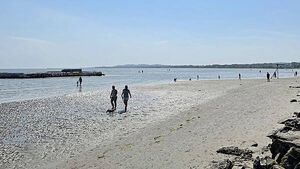'Tremendous improvement': Irish beaches are at their cleanest in eight years

Olivia Kelleher
Beaches in Ireland are at their cleanest in eight years, according to Irish Business Against Litter (IBAL), which has given credit to the Deposit Return Scheme for the "tremendous improvement” in their findings this year.
33 beaches, harbours, rivers, and their immediate environs were monitored by An Taisce on behalf of IBAL in June and July. 17 were deemed ‘clean.’
This represents a 50 per cent rise on the previous survey, while the number of areas branded ’littered’ fell from 11 to just three. Again, no area was placed in the lowest category “heavily littered",
Brittas Bay, Curracloe, Bundoran, Killiney, Strandhill, and Tramore were among the popular beaches to achieve clean status, alongside Portmarnock in Dublin, which registered a dramatic improvement on its previous ‘littered’ rating.
A similar improvement was noted at Blackrock Castle and Castletownbere in Cork. However, Dingle slipped to ‘littered’, as did Dog’s Bay beach in Galway, alongside White Bay in Cork.
Cigarette butts, sweet papers, and fast food wrappers were the most commonly found litter items.
The first coastal survey conducted since the introduction of the Deposit Return Scheme showed a 30 per cent drop in the prevalence of plastic bottles and cans.
Vapes were less prevalent than in previous studies, but there was no fall in coffee cup litter, which was found in 42 per cent of the sites surveyed.
IBAL spokesperson, Conor Horgan, told Newstalk Breakfast that the findings were very positive.
“We have been monitoring our beaches and waters for the last eight years and just a few years ago there were very few of those areas which were deemed clean - just a handful,” he said.
“Now over half of them are clean; it’s a change which has occurred just in the last few years.
“The other side of the coin, we used to talk about litter blackspots on our coastlines; there were areas deemed heavily littered, there’s no areas occupying those lower categories now."
Mr Horgan continued that the figures were “more remarkable” given how sunny the weather has been this year.
“That can prove a challenge to local authorities where, with our unpredictable weather, a beach can be empty one day and full the next,” he explained.
“It’s difficult to deploy resources to clean those areas - but they seem to have done a good job of it.”
Mr Horgan stated that there are variety of reasons behind the trend.
“I think just as we give credit to the Tidy Towns for the work in keeping our towns clean, I think credit must be given to the volunteers, to the Clean Coast groups that every week clean up our beaches,” he said.
“There’s a real appetite for this work and those groups are expanding. I think we’re seeing the fruits of this in the results today.”
Mr Horgan also credited two anti-littering initiatives brought in by the Government and the European Union.
“A simple thing like the tethering of caps to plastic bottles means this has disappeared as a litter form,” he said.
“With the Deposit Return Scheme, we’re also seeing a significant fall in the amount of plastic bottles and cans on our beaches.
“So, it’s a combination of factors. I think cleanliness begets cleanliness, I think you’re less likely to ruin a pristine beach than if litter is the norm on that beach,” he said.
However, Mr Horgan said that coffee cups remain a problem.
“If we’re going to do something about that, I think we need to look to a levy. That’s something that has been parked by the current Government.”
Meanwhile, according to National Geographic, about eight million tons of plastic waste escape into the oceans from coastal nations annually – the equivalent of five full rubbish bags for every foot of coastline in the world.
Over 2,000 species of wildlife, some endangered, are affected by plastics.
Next month’s Big Beach Clean Up is an annual call to action organised by An Taisce’s Clean Coasts, which is expected to attract over 600 groups and 15,000 volunteers nationwide to our beaches over a single weekend, from September 19th-21st.





